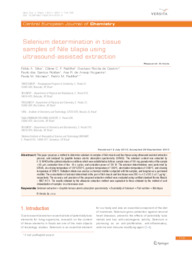Selenium determination in tissue samples of Nile tilapia using ultrasound-assisted extraction.
Selenium determination in tissue samples of Nile tilapia using ultrasound-assisted extraction.
Autoria: SILVA, F. A.; PADILHA, C. C. F.; CASTRO, G. R. de; ROLDAN, P. dos S.; NOGUEIRA, A. R. de A.; MORAES, P. M.; PADILHA, P. M.
Resumo: This paper proposes a method to determine selenium in samples of fish muscle and liver tissue using ultrasound assisted extraction process, and analysed by graphite furnace atomic absorption spectrometry (GFAAS). The selenium content was extracted by 0.10 M HCl at the optimal extraction conditions which were established as follows: sample mass of 100 mg; granulometry of the sample <60 ?m; sonication time of five 40 s cycles; and sonication power of 136 W. The selenium determinations were performed by GFAAS, at a drying temperature of 120oC/250oC, pyrolysis temperature of 1300oC, atomization temperature of 2300oC, and cleaning temperature of 2800oC. Palladium nitrate was used as a chemical modifier coinjected with the samples, and tungsten as a permanent modifier. The concentration of selenium determined in the pool of fish muscle and liver tissue were 280.4±4.2 e 592.3±6.7 ?g kg?1, respectively. The accuracy and precision of the proposed extraction method were evaluated using certified standard Bovine Muscle ? NIST 8414. The results obtained by the ultrasonic extraction method were equivalent to those obtained by the method of acid mineralization of samples in a microwave oven.
Ano de publicação: 2011
Tipo de publicação: Artigo de periódico
Unidade: Embrapa Pecuária Sudeste
Observações
1 - Por padrão são exibidas publicações dos últimos 20 anos. Para encontrar publicações mais antigas, configure o filtro ano de publicação, colocando o ano a partir do qual você deseja encontrar publicações. O filtro está na coluna da esquerda na busca acima.
2 - Para ler algumas publicações da Embrapa (apenas as que estão em formato ePub), é necessário ter, no celular ou computador, um desses softwares gratuitos. Sistemas Android: Google Play Livros; IOS: iBooks; Windows e Linux: software Calibre.
Acesse outras publicações
Acesse a Base de Dados da Pesquisa Agropecuária (BDPA) para consultar o acervo completo das bibliotecas da Embrapa.

